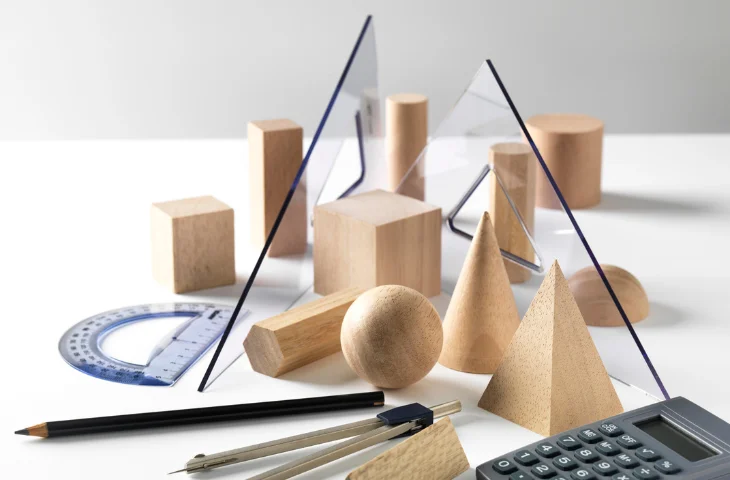Geometry is a crucial part of Quantitative Aptitude exams, focusing on shapes, sizes, and properties of figures and spaces. In this blog, we have provided all the details about Geometry from definitions, formulas, and tricks to types of questions, solved examples from recent exams, and important tips.
What Is Geometry in Quantitative Aptitude?
Geometry in Quantitative Aptitude deals with understanding and calculating properties of shapes like triangles, circles, rectangles, squares, and other polygons. It includes concepts such as perimeter, area, volume, angles, and coordinate geometry basics.
Geometry appears frequently in competitive exams because it tests your ability to understand shapes, apply formulas correctly, and solve problems logically under time constraints. Skills required include spatial reasoning, visualization, analytical thinking, and basic arithmetic.
Why Is Geometry Important in Competitive Exams?
Geometry is a scoring and time-efficient topic if practiced well. It tests fundamental math concepts and requires less memorization than some other topics.
| Exam | No. of Questions | Difficulty |
| SSC CGL / CHSL | 1–2 | Easy |
| IBPS PO / SBI PO | 1–2 | Moderate |
| RRB NTPC / Group D | 1 | Easy |
| State PSC / Police | 1–2 | Moderate |
Geometry Quantitative Aptitude Short Notes
Geometry involves many formulas and properties of shapes.
| Term | Explanation |
| Triangle | Area = ½ × base × height |
| Pythagoras Theorem | a² + b² = c² (for right-angled triangles) |
| Circle | Circumference = 2πr; Area = πr² |
| Rectangle | Area = length × breadth |
| Square | Area = side² |
| Volume of Cylinder | πr²h |
| Volume of Sphere | (4/3)πr³ |
| Angles in Polygon | Sum of interior angles = (n-2) × 180° |
Concepts Used in Geometry
The details of the concepts used to solve geometry questions are as follows:
| Concept | Details |
| Pythagoras Theorem | Relationship in right triangles |
| Area of Triangle | ½ × base × height |
| Circle Properties | Circumference = 2πr, Area = πr² |
| Volume Formulas | Cylinder, Sphere, Cone volumes |
| Angle Sum Property | (n-2) × 180° for polygons |
| Coordinate Geometry | Distance and midpoint formulas |
What Are the Types of Geometry Questions in Quantitative Aptitude?
Geometry questions in exams come in different formats testing your concept clarity and speed:
- Direct: Straightforward calculation of area, perimeter, or volume
- Puzzle-based: Problems combining multiple shapes or requiring logical deduction
- Coded (symbol-based): Questions involving coded symbols representing geometric figures or angles
- Mixed-concept: Combining geometry with algebra or coordinate geometry
Geometry Formulas for Quantitative Aptitude
Memorizing formulas helps solve problems quickly. Some of the commonly used formulas are as follows:
- Triangle Area = ½ × base × height
- Right Triangle: Hypotenuse² = sum of squares of other two sides
- Circle: Circumference = 2πr, Area = πr²
- Rectangle & Square: Area = length × breadth, side² respectively
- Volume: Cylinder = πr²h, Sphere = (4/3)πr³, Cone = (1/3)πr²h
- Sum of interior angles of polygon = (n-2) × 180°
- Exterior angle of polygon = 360° / n
Geometry Tricks for SSC CGL and Other Exams
Some of the time-saving tricks used to solve geometry questions are as follows:
- Always draw a neat diagram to visualize the problem
- Use Pythagoras theorem for right-angle problems quickly
- Start by identifying known sides or angles first
- Break complex figures into simple shapes (triangles, rectangles)
- Remember key formulas instead of re-deriving during exams
- Eliminate options using approximate values if stuck
- Practice mental math for π approximations (3.14 or 22/7)
Solved Geometry Questions from 2024–25 Exams
1. SSC CGL 2024 Tier 1 – Shift 2 (Memory-Based)
Question: The diagonal of a rectangle is 13 cm, and one side is 5 cm. Find the area.
Answer: 60 cm²
Explanation: Use Pythagoras theorem to find the other side:
√(13² – 5²) = √(169 – 25) = √144 = 12
Area = 5 × 12 = 60 cm²
2. IBPS PO Prelims 2024
Question: Find the volume of a cylinder with radius 7 cm and height 10 cm.
Answer: 1540 cm³
Explanation: Volume = πr²h = 3.14 × 7² × 10 = 3.14 × 49 × 10 = 1538.6 ≈ 1540 cm³
3. RRB NTPC 2024
Question: Sum of interior angles of a polygon is 1440°. Find the number of sides.
Answer: 10 sides
Explanation: (n-2) × 180 = 1440 → n-2 = 8 → n = 10
Sources: SSC PDF, IBPS official mock, RRB memory-based.
Common Mistakes to Avoid while Solving Geometry
While solving Geometry questions candidates must avoid:
- Not drawing diagrams, leading to confusion. Always sketch first.
- Forgetting to use correct units in measurements.
- Mixing up formulas for area and perimeter.
- Ignoring the Pythagoras theorem in right-angle problems.
- Overcomplicating problems without breaking them down into simpler shapes.
FAQs
Focus on memorizing key formulas, practice drawing diagrams quickly, and use elimination methods.
Questions where figures or angles are represented by symbols or codes requiring decoding.
Area and perimeter formulas for common shapes, Pythagoras theorem, volume formulas.
Yes, basic coordinate geometry involving distance and midpoint formulas is often included.
Practice drawing shapes and solving puzzle-based questions regularly.
- BOI Apprentice Salary 2025, Check Stipend Details
- Upcoming Bank Exams 2026: SBI, IBPS, IBPS RRBs, Insurance Exams
- Bank of India Credit Officer Syllabus 2025, Check Exam Pattern
- Punjab and Sind Bank LBO Interview Result 2025 Out, Download PDF
- SSC CGL Tier 2 Previous Year Paper, Download Free PDF
- SSC CGL 2025 Tier 1 Question Papers, Shift-Wise PYPs, Download PDFs

Hi, I’m Aditi. I work as a Content Writer at Oliveboard, where I have been simplifying exam-related content for the past 4 years. I create clear and easy-to-understand guides for JAIIB, CAIIB, and UGC exams. My work includes breaking down notifications, admit cards, and exam updates, as well as preparing study plans and subject-wise strategies.
My goal is to support working professionals in managing their exam preparation alongside a full-time job and to help them achieve career growth.
